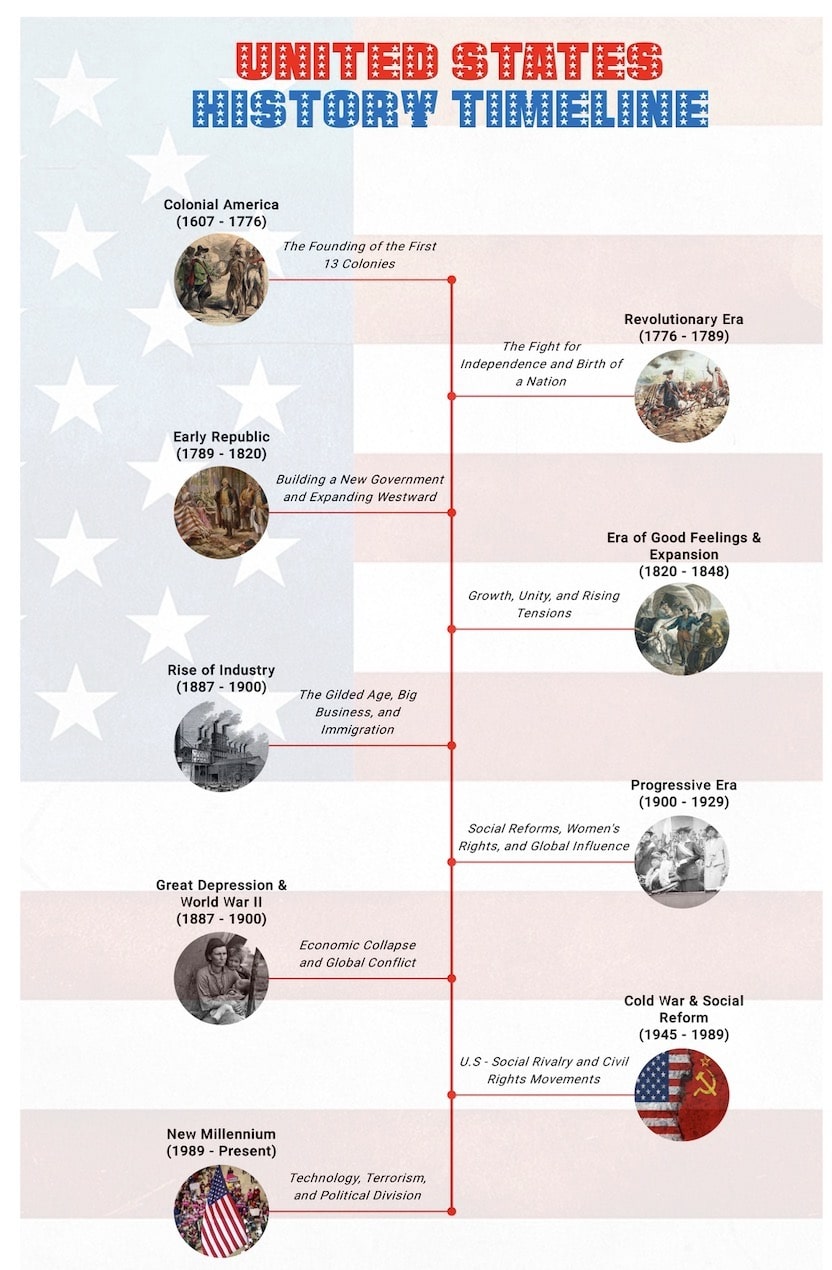Every nation has a beginning, and the story of the United States is full of twists and turns. Long before the idea of “America” existed, Native peoples lived across this land, building cultures, traditions, and communities that lasted for thousands of years.
Then came explorers and settlers from England, France, Spain, and the Netherlands. Small, struggling colonies soon grew into thriving communities. Over time, they wanted independence, and the fight for freedom gave birth to a new nation. From that moment, America’s long and complex journey truly began.
In this article
U.S History Timeline
The story of the United States began in 1607. Over the centuries, people have fought wars, built communities, and pushed for rights and equality. The nation has faced setbacks but kept moving forward. This timeline tells that story. It shows how America was built, tested, transformed over time.
Colonial America (1607-1776)
Colonial America was where it all began. In 1607, Jamestown became the first lasting English settlement. Life was brutal, hunger, sickness, and conflict made every day a struggle. But slowly, new colonies appeared, each with its own culture and purpose.
Some settlers came chasing riches, others seeking religious freedom. Over time, thirteen colonies stretched along the Atlantic coast. But they weren’t free. Britain controlled trade and raised taxes, and resentment grew. “No taxation without representation” became the rallying cry. By the 1770s, the colonies were done with compromise. Independence was in the air, and the Revolution was coming.
Revolutionary Era (1776-1789)
In 1776, the colonies made their boldest move: they declared independence. War broke out. It was long, bloody, and uncertain. George Washington led the scrappy Continental Army against the mighty British forces, and somehow, against all odds, the colonies won.
But victory wasn’t the end. The Articles of Confederation created a weak and messy government. In 1787, leaders met in Philadelphia and wrote the Constitution, building a stronger foundation. It balanced powers and set lasting rules for the new nation. In 1789, George Washington became the first president. America was young, bold, and ready to try something new: a republic built on liberty.
Early Republic (1789-1820)
America was just learning how to govern itself. Washington set the example, two terms, peaceful leadership, no kings. But politics heated up quickly. Federalists and Democratic-Republicans clashed over government power.
Then came growth. In 1803, the Louisiana Purchase doubled the nation’s size. Lewis and Clark explored the vast new lands, meeting Native tribes and mapping rivers and mountains. Trouble followed too. The War of 1812 tested America once again. After a rocky start, the U.S. held its ground. By 1820, the nation was still young but hopeful. The future seemed wide open.
Era of Good Feelings & Expansion (1820-1848)
After the War of 1812, the country felt united. President Monroe’s time in office was called the “Era of Good Feelings.” But beneath the peace, divisions were growing, especially over slavery.
Expansion was the big theme. Roads, canals, and railroads connected the country. Families rushed west, chasing farmland and opportunity. But Native Americans suffered most. The Indian Removal Act of 1830 forced thousands from their homes, leading to the Trail of Tears. America was booming, but cracks were forming. Slavery, states’ rights, and expansion were sparking storms.
Sectionalism & Crisis (1848-1860)
The U.S. kept expanding, and so did its troubles. Every new territory raised the same question, would slavery spread west? The Compromise of 1850 tried to settle things but only deepened the divide.
Violence broke out in Bleeding Kansas, where neighbors fought over slavery. The Dred Scott decision declared enslaved people property, not citizens. Lincoln’s rise to prominence shook the South. By 1860, when he won the presidency, trust was gone. Southern states began to secede. The nation was splitting apart, and civil war was inevitable.
Civil War & Reconstruction (1860-1877)
From 1861 to 1865, the Civil War ripped the country apart. It became the deadliest war in U.S. history. Major battles like Gettysburg and Vicksburg shaped the outcome. Lincoln’s Emancipation Proclamation gave the fight a higher purpose, ending slavery.
The Union eventually won, but victory came at a cost. Lincoln was assassinated just days after the war ended. Reconstruction followed. The 13th, 14th, and 15th Amendments promised freedom and rights for formerly enslaved people. But resistance was fierce. White supremacist groups rose, and by 1877, federal troops left the South. Reconstruction ended, and equality slipped away.
Rise of Industry (1877-1900)
After the war came growth. The Gilded Age brought railroads, oil, and steel. Business giants like Rockefeller and Carnegie grew rich, and America’s economy soared.
But workers paid the price. Long hours, low wages, and dangerous conditions were common. Cities swelled with immigrants chasing the American Dream, but overcrowding and poverty spread. Strikes and protests shook the nation. The Dawes Act stripped Native Americans of land and culture. America was richer than ever, but inequality and injustice ran deep.
Progressive Era (1900-1929)
The new century sparked reform. Journalists called muckrakers exposed corruption and abuse. Leaders like Theodore Roosevelt tackled monopolies and fought for workers’ rights.
The Progressive Era brought safer working conditions, fairer laws, and more power for voters. Women won the right to vote in 1920. Abroad, America flexed its strength, building the Panama Canal and fighting wars. The Roaring Twenties followed, jazz, radios, and booming business. But behind the party, debt and speculation grew. The crash was coming.
Great Depression & WWII (1929-1945)
The stock market crash of 1929 shattered the economy. Banks collapsed, millions lost jobs, and families struggled to survive. Franklin D. Roosevelt’s New Deal brought jobs, programs, and hope, but the Depression lingered.
Then came World War II. After Pearl Harbor in 1941, America entered the fight. Factories roared to life, women filled jobs at home, and soldiers battled overseas. By 1945, victory came, but at a terrible price. The war ended with the atomic bomb. Millions were dead, and the U.S. emerged as a global superpower in a changed world.
Cold War Era & Social Reform (1945-1989)
After WWII, the U.S. and Soviet Union became locked in the Cold War. It wasn’t direct fighting but an arms race, a space race, and global rivalry. Fear of nuclear war loomed large.
At home, the Civil Rights Movement challenged segregation. Martin Luther King Jr. and others led marches for equality. The 1960s and ’70s brought protests, assassinations, the Vietnam War, and Watergate. In the 1980s, Ronald Reagan’s presidency brought new energy and big defense spending. By 1989, the Berlin Wall fell, and the Cold War ended.
New Millennium (1989-Present)
The 1990s brought new technology, booming business, and peace efforts. But in 2001, the 9/11 terrorist attacks changed everything. America launched the War on Terror in Afghanistan and Iraq.
In 2008, Barack Obama made history as the first Black president. But political divides deepened. Donald Trump’s presidency stirred fierce debates and ended with the Capitol riot in 2021. Joe Biden took office during a pandemic, tackling global and domestic challenges. By 2025, America remains divided yet resilient. The story is still being written.
How to Make the US History Timeline in EdrawMax?
The story of the United States is long and complex, but presenting it doesn’t have to be. With EdrawMax, you can design a professional-looking timeline in no time. The timeline maker's drag-and-drop features and customizable templates make the process quick and enjoyable.
Let’s go step-by-step on how to create your US history timeline using EdrawMax:
Step1Start With a Blank Canvas
- Open EdrawMax on your desktop.
- Log in or sign up if you don’t have an account.
- Click New on the left panel and select Blank Drawing to open a fresh canvas for your technology timeline.
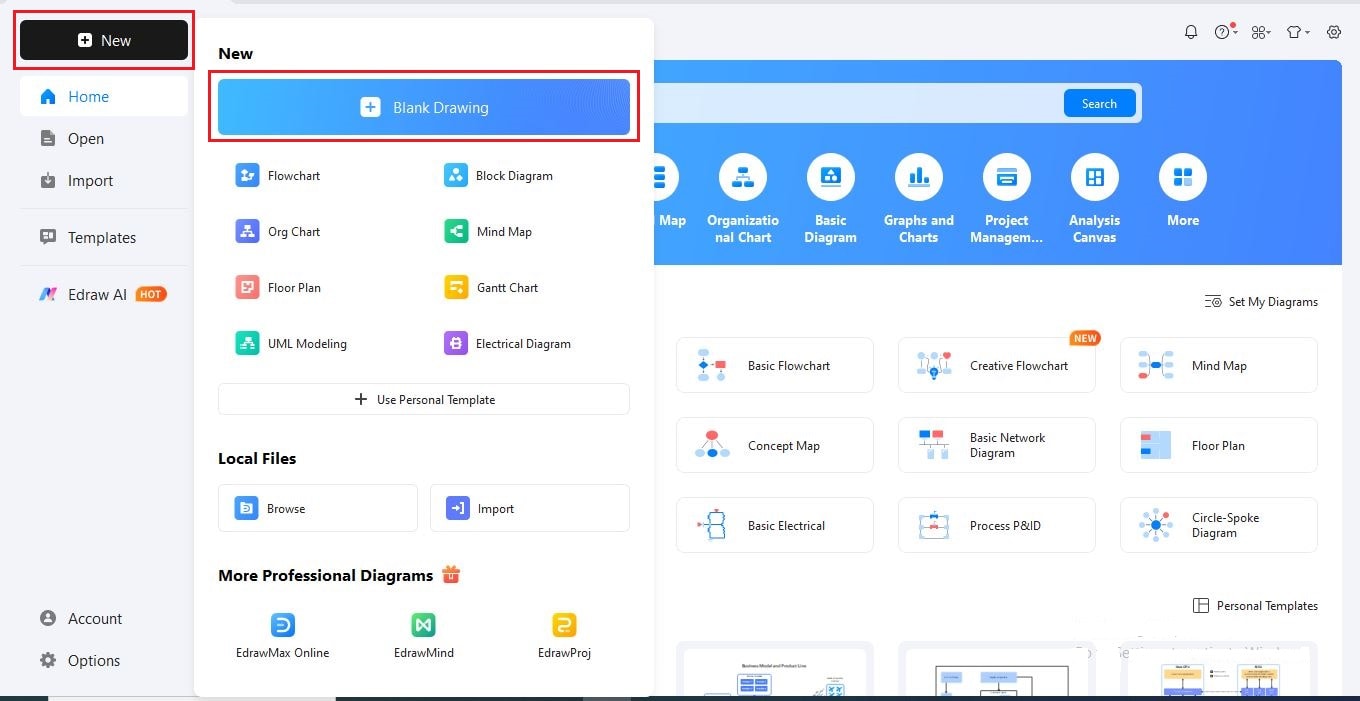
Step2Insert a Background Image
- Go to Insert on the top toolbar and select Picture.
- Choose Local Pictures to upload an image for your timeline background.
- To adjust brightness, contrast, or transparency, click the image and use the Adjust panel.
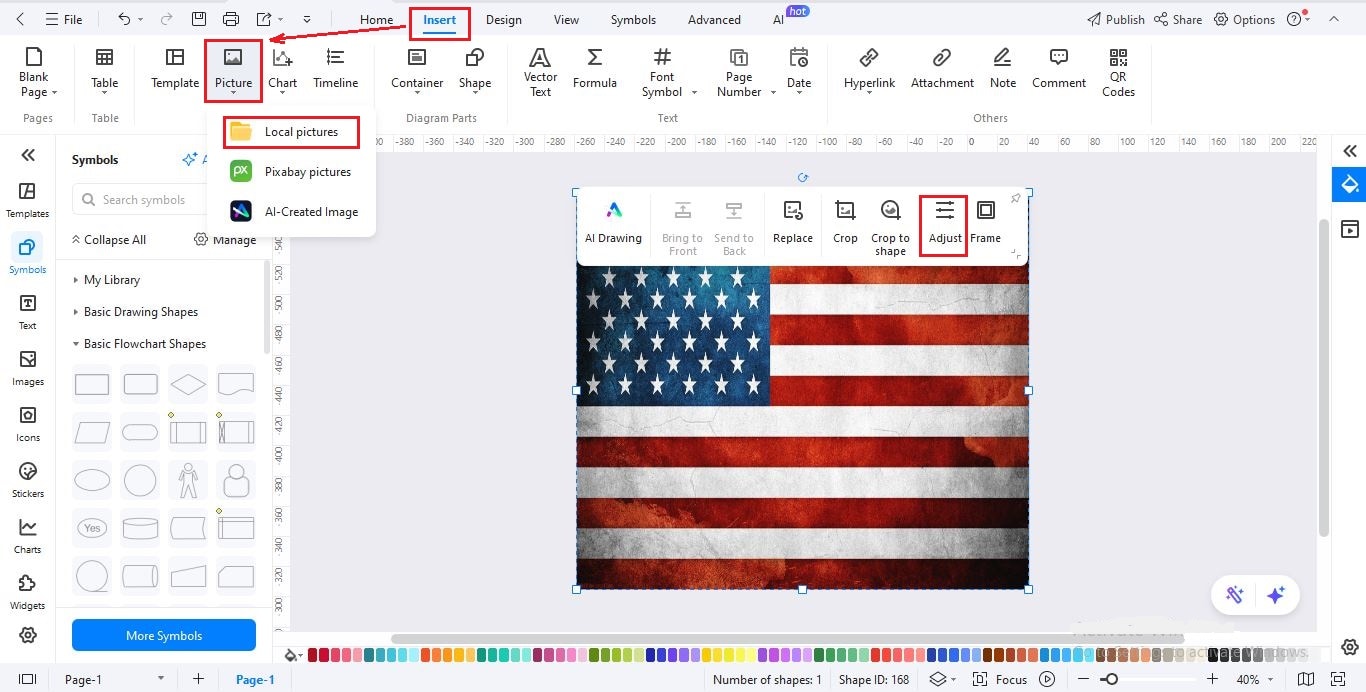
Step3Add a Heading
- Add a heading using a text box or an image.
- Go to the top menu bar: Insert > Picture > Local Pictures to upload a title image like “United States History Timeline”
- Optionally, add an icon or symbol to complement your heading.
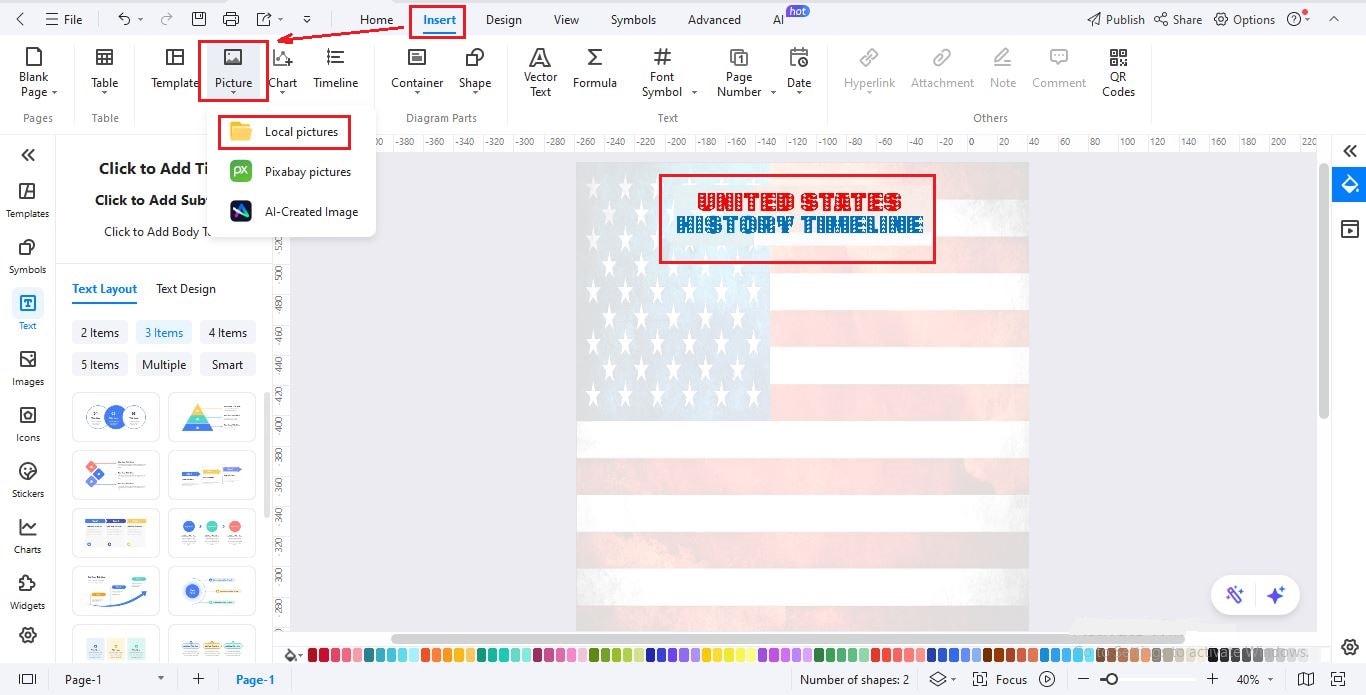
Step4Insert the Timeline
- Click Insert on the top toolbar.
- Select Timeline, scroll down to Vertical Timeline, and pick the 4th style, which includes images.
- Click OK to add it to your canvas.
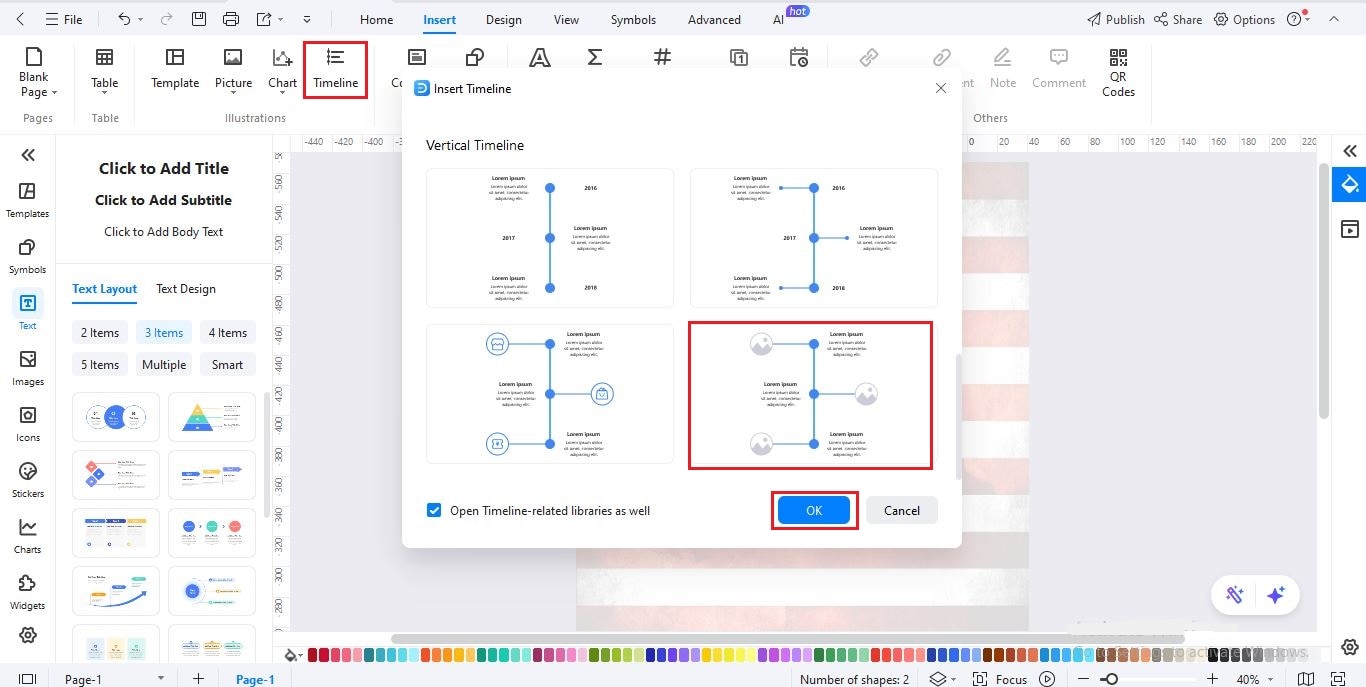
Step5Add Text to the Timeline
- Click Text on the left panel.
- Use Click to Add Subtitle to enter the first milestone date.
- Use Click to Add Body to describe the key event.
- Continue adding remaining dates and events.
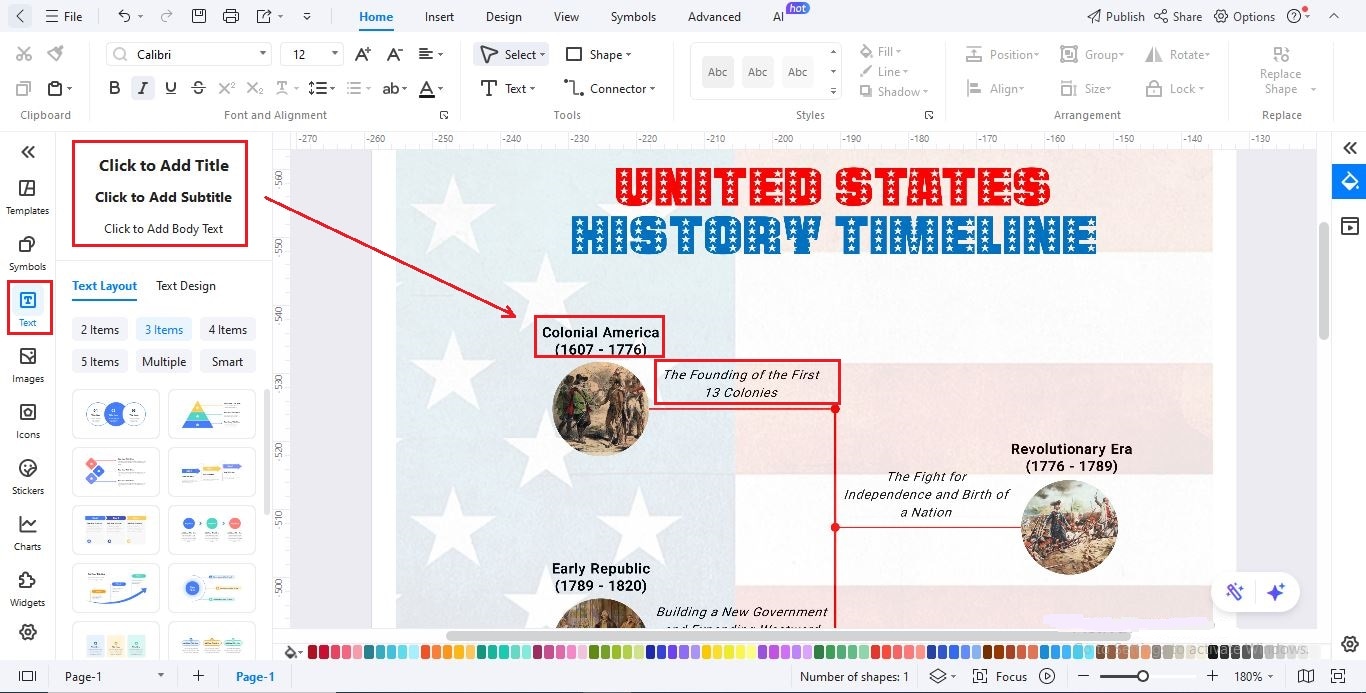
Step6Insert Thumbnail Images
- Enhance your timeline with images for each event.
- Go to Insert > Picture > Local Pictures and add thumbnails.
- To change outlines, click the image, select Crop to Shape, and pick a suitable frame.
- Repeat this process for all the events.
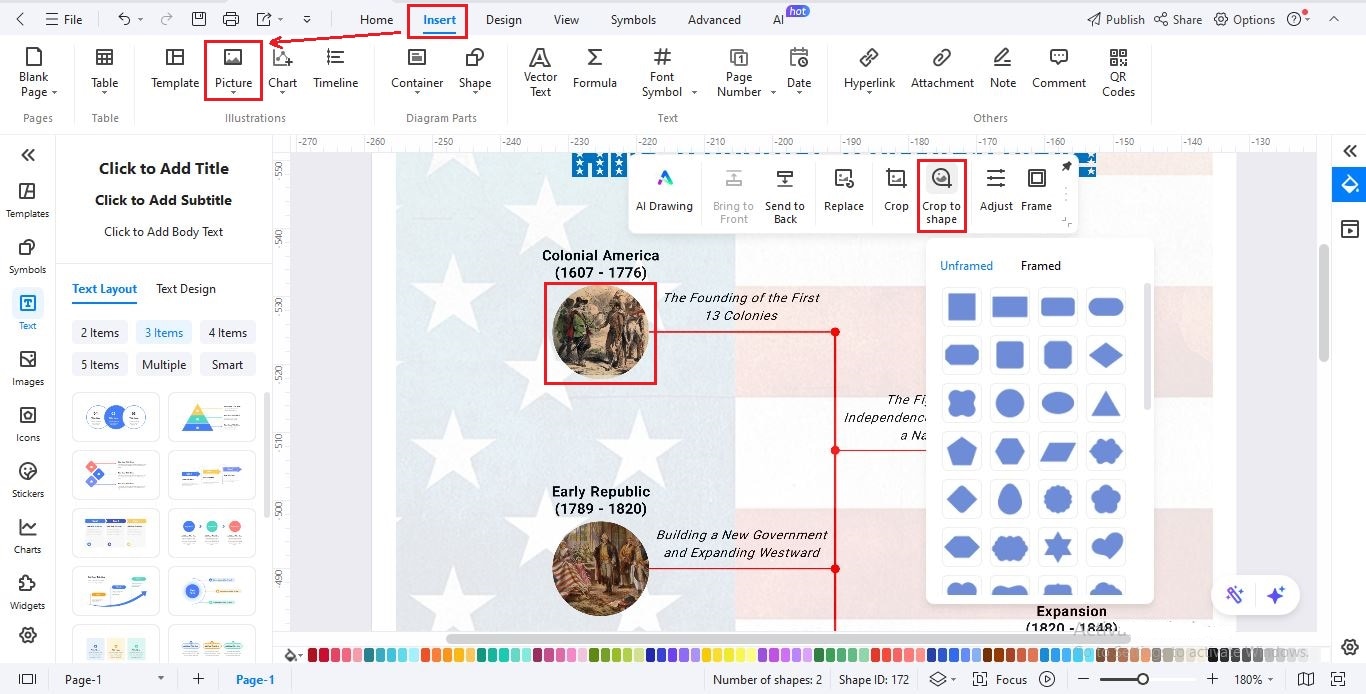
Step7Save, Share, or Export
- Click File > Save to keep an editable version.
- Use Share to collaborate or send your timeline to others.
- To export, go to File > Export and choose a format such as PNG, PDF, SVG, HTML, Visio, or Excel.
- Click Publish to share your technology timeline with the EdrawMax community.
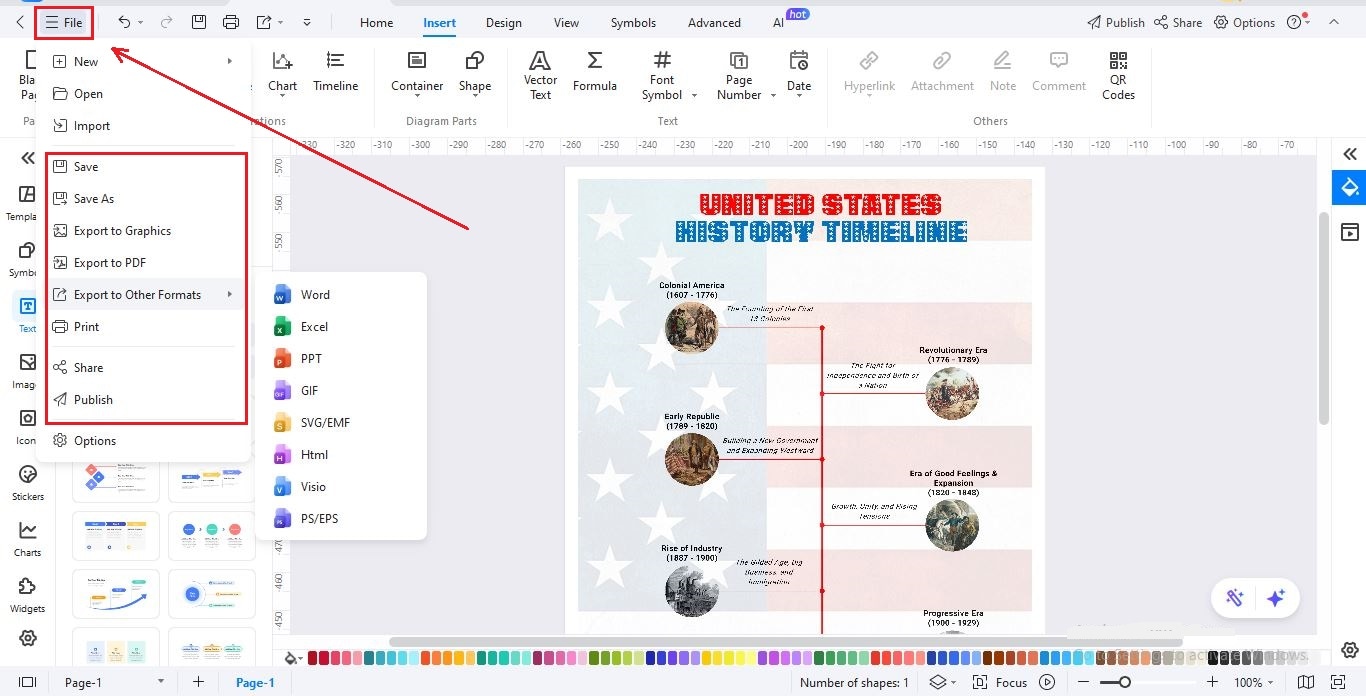
Looking Forward: Future of the United States
America’s story isn’t finished yet. Every generation faces challenges, wars, disagreements, economic struggles, or fights for fairness. But every generation also brings new ideas, fresh energy, and hope for change. That’s always been part of the journey.
The U.S. has never been perfect, but it has always found a way to move forward. The choices people make today will shape tomorrow. And if you ever want to organize history, or even your own ideas, EdrawMax makes it simple. It's an easy to use tool for creating timelines and telling your story.




